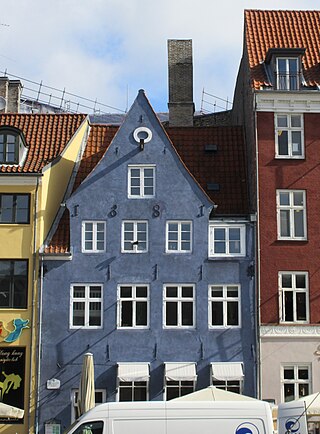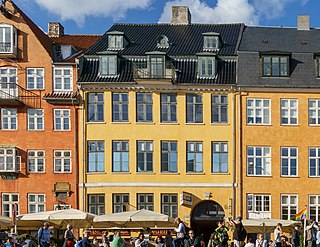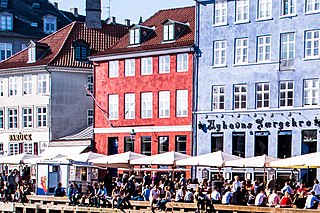
Nyhavn 11 is an 18th-century property overlooking the Nyhavn canal in central Copenhagen, Denmark. Ludvig Ferdinand Rømer established a sugar refinery on the property in 1653 and it was later continued by changing owners until at least the 1860s. A small figure of a sugar-baker holding a sugar cone is still seen above the gate. The building was listed in the Danish registry of protected buildings and places in 1932. Notable former residents include the general trader Jacob Severin and actors Christen Niemann Rosenkilde, Julie Sødring and Poul Reumert. The lamp manufacturer Louis Poulsen was later based in the building from 1908 to 2006.

The Verrayon House is a Rococo, bourgeoisie townhouse located at Lille Strandstræde 6 in central Copenhagen, Denmark. It was listed by the Danish Heritage Agency in the Danish national registry of protected buildings in 1943.

Nyhavn 9 is a historic townhouse overlooking the Nyhavn Canal in central Copenhagen, Denmark. It dates back to the 17th century and is one of few buildings along the canal that was not heightened in the 19th century. The building was listed on the Danish Registry of Protected Buildings and Places in 1918. It houses a restaurant in the ground floor.

Nyhavn 15 is a historic townhouse overlooking the Nyhavn Canal in central Copenhagen, Denmark. The building was listed in the Danish registry of protected buildings and places in 1945.

Nyhavn 41 is a listed property overlooking the Nyhavn canal in central Copenhagen, Denmark. For most of the 19th century, the property was owned by a family of sailmakers. The manufacturing of flags and compasses was also part of their trade. The building was listed in the Danish registry of protected buildings and places in 1918.

Nyhavn 43 is a historic townhouse overlooking the Nyhavn Canal in central Copenhagen, Denmark. The building was listed on the Danish registry of protected buildings and places in 1945. It was refurbished in 1987.

Lille Strandstræde 10 is an 18th-century property situated in the Nyhavn Quarter of central Copenhagen, Denmark. It was listed in the Danish registry of protected buildings and places in 1988.

Lille Strandstræde 3 is a Neoclassical property in the Nyhavn Quarter of central Copenhagen, Denmark. The building was listed in the Danish registry of protected buildings and places in 1979.

Nyhavn 45 is an 18th-century property overlooking the Nyhavn Canal in central Copenhagen, Denmark. It was listed in the Danish registry of protected buildings and places in 1945.

Nyhavn 3 is an 18th-century property overlooking the Nyhavn Canal in central Copenhagen, Denmark. It was listed in the Danish registry of protected buildings and places in 1945.

Nyhavn 37 is an 18th-century property overlooking the Nyhavn Canal in central Copenhagen, Denmark. A distillery was based in a rear wing from a least 1731 until at least the 1860s. The building was heightened with one storey in 1791. The building was listed in the Danish registry of protected buildings and places in 1923.

Torvegade 22 is an 18th-century property situated on Torvegade in the Christianshavn neighborhood of central Copenhagen, Denmark. The building was from its construction in 1714 to 1902 owned by bakers and the site of one of two bakeries in the street. A gilded kringle can still be seen above the main entrance. The other bakery was situated a little further down the street at Torvegade 28. The building was listed in the Danish registry of protected buildings and places in 1950.

Snaregade 8 is a Neoclassical building situated close to Gammel Strand in the Old Town of Copenhagen, Denmark. It was listed in the Danish registry of protected buildings and places in 1045. Notable former residents include the politician Frederik Frølund.

Lille Strandstræde 8 is an 18th-century property situated around the corner from Nyhavn in central Copenhagen, Denmark. Constructed as a two-storey, half-timbered building for Andreas Bodenhoff in the middle of the century, it was later first reconstructed in brick and heightened with two storeys in 1783 and then, in 1932, expanded with a seven-bays-long side wing on the rear. The building was listed in the Danish registry of protected buildings and places in 1959. Notable former residents include the German painter Bernhard Mohrhagen and the veterinarian Viggo Stockfleth.

Nyhavn 53, also known as Madame Tofte's House, is a residential building overlooking the Nyhavn canal in central Copenhagen, Denmark. It was constructed with three storeys in the 1750s but owes its current appearance to a renovation in the 1870s. It was listed in the Danish registry of protected buildings and places in 1932. Notable former residents include the composer Peter Arnold Heise and the ballet dancer Augusta Nielsen. The Adventurers' Club of Denmark is based in a half-timbered warehouse in the courtyard.

Nyhavn 20 is a 17th-century building overlooking the Nyhavn canal in central Copenhagen, Denmark. It was listed in the Danish registry of protected buildings and places in 1945. The building houses a bar in the basement and a residential apartment on the upper floors. The facade features a relief of a fish above the main entrance, flanked by two reliefs of sailing ships.

Nyhavn 61 is an 18th-century residential building overlooking the Nyhavn canal in central Copenhagen, Denmark. The building was listed in the Danish registry of protected buildings and places in 1945. The scope of the heritage listing was expanded in 1984. Nyhavn 61 and Nyhavn 59 have now been merged into a single property and are physically integrated on the third floor. The two buildings share a central courtyard.

Nyhavn 5 is an 18th-century property overlooking the Nyhavn canal in central Copenhagen, Denmark. It was listed in the Danish registry of protected buildings and places in 1945. Notable former residents include the actor Adam Gottlob Gielstrup, opera singer Peter Schram and businessman Cornelius Peter August Koch.

Kvæsthusgade 1/Nyhavn 69 is a three-storey building situated at the corner of Nyhavn and Kvæsthusgade. A memorial featuring a bust of a diver wearing a diving helmet commemorates that Em. Z. Svitzer's Bjernings-Enterprise, a salvage company founded by Emil Zeuthen Svitzer back in 1833, was once headquartered in the building. Notable former residents include the actress Magda von Dolcke.

Nyhavn 57 was a late 17th-century building overlooking the Nyhavn Canal in central Copenhagen, Denmark. The property was listed in the Danish registry of protected buildings and places in 1945. Notable former residents include the artist Heinrich Gustav Ferdinand Holm, Hedeselskabet co-founder Niels Georg Christian Morville and D/S Norden-founder Mads Christian Holm.

































